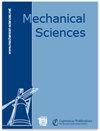基于径向基函数神经网络和模糊逻辑算法的终端滑模控制的自动驾驶汽车轨迹跟踪横向控制
IF 1.5
4区 工程技术
Q4 ENGINEERING, MECHANICAL
引用次数: 1
摘要
摘要本文将研究一种基于终端滑模控制器的电动汽车轨迹跟踪控制算法。首先,建立了3自由度非线性车辆模型和面向控制器的2自由度车辆模型。根据预览模型自适应调整预览时间。然后,设计了采用终端滑模算法的车辆轨迹跟踪控制器。采用径向基函数(RBF)神经网络算法在线逼近控制模型中的系统变量参数。同时,采用模糊逻辑对控制器的增益参数进行控制,以减小控制系统的抖振。最后,通过仿真对所设计的控制器进行了验证。不同速度下路径跟踪的最大偏差为0.6 m,在不同路面摩擦系数下也能很好地跟踪目标路径。仿真结果表明,所设计的控制器能够有效地进行车辆轨迹跟踪和横向控制,并在一定程度上减小抖振。本文章由计算机程序翻译,如有差异,请以英文原文为准。
Autonomous vehicle trajectory tracking lateral control based on the terminal sliding mode control with radial basis function neural network and fuzzy logic algorithm
Abstract. This paper will study a trajectory tracking control algorithm for electric vehicles based on a terminal sliding mode controller. First, a 3 degrees of freedom nonlinear vehicle model and a controller-oriented 2 degrees of freedom vehicle model are established. The preview time is adaptively adjusted based on the preview model. Then, the vehicle trajectory tracking controller, which uses the terminal sliding mode algorithm, is designed. The radial basis function (RBF) neural network algorithm is used to approximate the system variable parameters in the control model online. At the same time, fuzzy logic is used to control the gain parameters of the controller to reduce the chattering of the control system. Finally, the designed controller is verified by simulation. The maximum deviation of path tracking under different speeds is 0.6 m, and the target path can also be well followed under different road friction coefficients. The simulation results show that the controller designed in this paper can effectively carry out the vehicle trajectory tracking and lateral control and reduce the chattering to a certain extent.
求助全文
通过发布文献求助,成功后即可免费获取论文全文。
去求助
来源期刊

Mechanical Sciences
ENGINEERING, MECHANICAL-
CiteScore
2.20
自引率
7.10%
发文量
74
审稿时长
29 weeks
期刊介绍:
The journal Mechanical Sciences (MS) is an international forum for the dissemination of original contributions in the field of theoretical and applied mechanics. Its main ambition is to provide a platform for young researchers to build up a portfolio of high-quality peer-reviewed journal articles. To this end we employ an open-access publication model with moderate page charges, aiming for fast publication and great citation opportunities. A large board of reputable editors makes this possible. The journal will also publish special issues dealing with the current state of the art and future research directions in mechanical sciences. While in-depth research articles are preferred, review articles and short communications will also be considered. We intend and believe to provide a means of publication which complements established journals in the field.
 求助内容:
求助内容: 应助结果提醒方式:
应助结果提醒方式:


